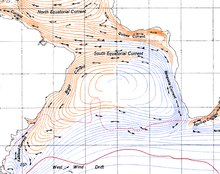South Equatorial Current
The South Equatorial Current (Engl. South Equatorial Current ) is a permanent warm ocean current from east to west in the Pacific , Atlantic and in the Indian Ocean .
In the Pacific, the South Equatorial Current arises from the cold Humboldt Current . On the coast of Peru , the Humboldt Current is deflected to the west due to the Coriolis force and flows along and south of the equator towards Australia and Southeast Asia. Since it transports large amounts of water, the water level in the target areas is measurably increased. The climate of the Galapagos Islands is dominated by this current.
In the Atlantic, the South Equatorial Current draws its water from the Benguela Current , crosses the Atlantic at the equator in a westerly direction, and then flows northwest to the Caribbean on the northeast coast of Brazil . It is the main supplier of water to the Gulf Stream .
In the Indian Ocean, the South Equatorial Current arises from the West Australian Current and flows south of the equator westwards towards Madagascar .
